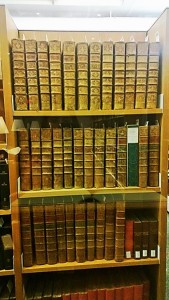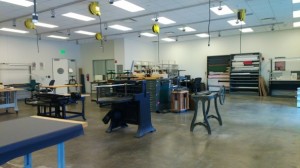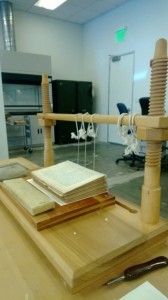
This post was written by Morgan Arronson, intern in the Dibner Library for the History and Science and Technology and Preservation Department.
If you want to stay cool during DC’s hot and humid summer, head to the Smithsonian and find the nearest rare book. Instantly a wave of cool air will rush by. This may sound strange but it works every time.
Here at the Smithsonian’s Dibner Library and the Book Conservation Lab located in Landover, MD, where I’ve been interning for the past six weeks, rare and precious texts are kept in climate controlled environments with humidity and temperature levels set to levels bordering on chilly. Wandering the stacks will give anyone goose bumps—not only because of the cool temperatures but also because of the incredible library materials stored there.
While keeping cool in the stacks, one of the most interesting items I saw is the Dibner Library’s most famous; a letter written and signed by Galileo himself in 1625, which was recently featured on BBC television.
Another great piece held by the Dibner Library is a bound manuscript, De proprietatibus rerum (photo above), written by an English Benedictine monk in the 13th century. Beautifully illuminated with handwriting so perfect it looks printed, it is truly one of the nation’s treasures.

My most favorite item in the Dibner Library is a full set of the first edition of the French Great Encyclopedia! Now, I know encyclopedias don’t typically inspire fervent emotion, but this endeavor by Diderot and D’Alembert from the 18th century was humankind’s first attempt to contain all human knowledge between a set of two-book covers. It was basically the 18th century’s wikipedia. It is also one of the few treasures that can be viewed from the window in the Dibner Library’s reading room.
Despite the library’s best efforts and the wonderful climate controlled environment, some books in the collection need a little, or a lot, of TLC. Any damaged book, from the rare to the reference, is sent to the ‘book doctors’ working in the Smithsonian’s Book Conservation Lab (BCL).
At the BCL, just three conservators take care of the Smithsonian’s entire book collection, amounting to millions of volumes. From crumbling acidic paper to scotch tape to bugs and dirt, these conservators give old books second lives. I tried my hand at it, with a lot of help and patience from the staff, and was able in the end to do more good than harm (I hope).

I was tasked with disbinding a crumbling 19th century book and then putting it all back together. I soon discovered this book should have been branded with a “handle with extreme caution” label, as with every turn of the page the edges would simply crumble. Despite the torn pages, missing spine and other difficulties, I was able to sew the book sections together and bind it using its original boards. This process all in all took me about six 8 hour days, a snail’s pace when compared to the other conservators. But it was an experience where the value of patience and the feeling of achievement are truly realized.

The Smithsonian Libraries is hidden among the museums more advertised treasures. If you want to help books in need, you can adopt a book today through the Smithsonian’s Adopt-A-Book program. Books up for adoption are often incredible works in states of great disrepair. Adopting a book will enable it to be sent to the conservators at the BCL for any repair it may require. After the restoration is completed your name will be recorded for posterity on a book plate placed inside the book. Click here for more information, and visit the Smithsonian Libraries for a nice cool climate-controlled break from the heat!

Be First to Comment